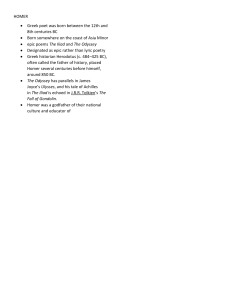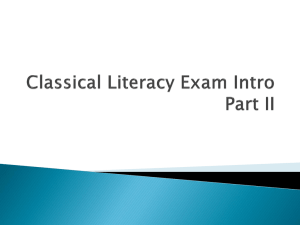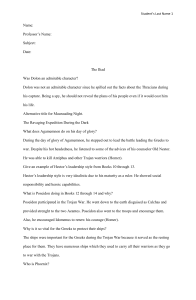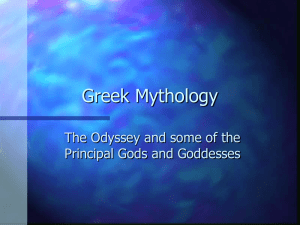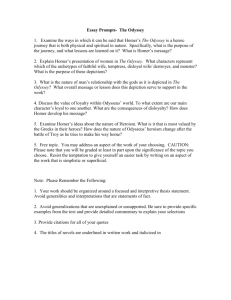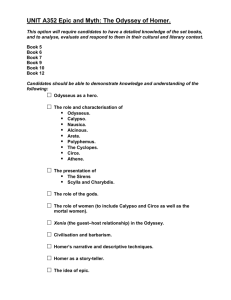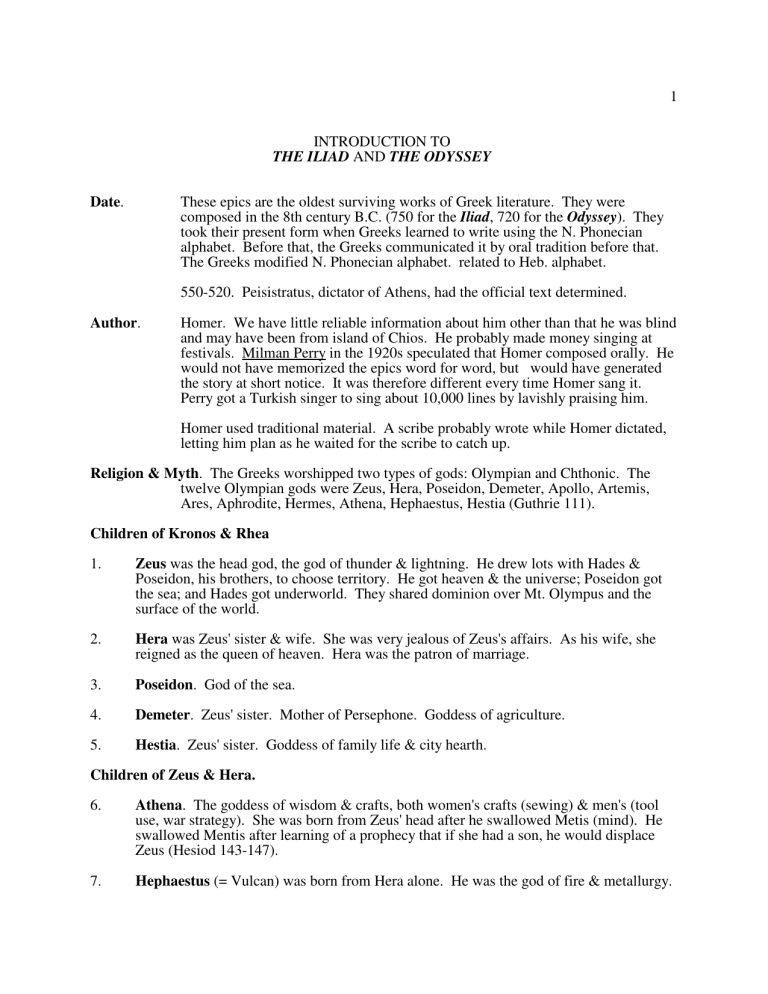
1 INTRODUCTION TO THE ILIAD AND THE ODYSSEY Date. These epics are the oldest surviving works of Greek literature. They were composed in the 8th century B.C. (750 for the Iliad, 720 for the Odyssey). They took their present form when Greeks learned to write using the N. Phonecian alphabet. Before that, the Greeks communicated it by oral tradition before that. The Greeks modified N. Phonecian alphabet. related to Heb. alphabet. 550-520. Peisistratus, dictator of Athens, had the official text determined. Author. Homer. We have little reliable information about him other than that he was blind and may have been from island of Chios. He probably made money singing at festivals. Milman Perry in the 1920s speculated that Homer composed orally. He would not have memorized the epics word for word, but would have generated the story at short notice. It was therefore different every time Homer sang it. Perry got a Turkish singer to sing about 10,000 lines by lavishly praising him. Homer used traditional material. A scribe probably wrote while Homer dictated, letting him plan as he waited for the scribe to catch up. Religion & Myth. The Greeks worshipped two types of gods: Olympian and Chthonic. The twelve Olympian gods were Zeus, Hera, Poseidon, Demeter, Apollo, Artemis, Ares, Aphrodite, Hermes, Athena, Hephaestus, Hestia (Guthrie 111). Children of Kronos & Rhea 1. Zeus was the head god, the god of thunder & lightning. He drew lots with Hades & Poseidon, his brothers, to choose territory. He got heaven & the universe; Poseidon got the sea; and Hades got underworld. They shared dominion over Mt. Olympus and the surface of the world. 2. Hera was Zeus' sister & wife. She was very jealous of Zeus's affairs. As his wife, she reigned as the queen of heaven. Hera was the patron of marriage. 3. Poseidon. God of the sea. 4. Demeter. Zeus' sister. Mother of Persephone. Goddess of agriculture. 5. Hestia. Zeus' sister. Goddess of family life & city hearth. Children of Zeus & Hera. 6. Athena. The goddess of wisdom & crafts, both women's crafts (sewing) & men's (tool use, war strategy). She was born from Zeus' head after he swallowed Metis (mind). He swallowed Mentis after learning of a prophecy that if she had a son, he would displace Zeus (Hesiod 143-147). 7. Hephaestus (= Vulcan) was born from Hera alone. He was the god of fire & metallurgy. 2 He was also lame. He made thunderbolts for Zeus, and arms for gods & heroes. He Forged under Mt. Olympus & Mt. Etna, and the Cyclopes worked for him. 8. Ares (= Mars). son of Zeus & Hera. god of war. His war frenzy contrasts with Athena's rational approach to war. Children of Zeus & Leto 9. Apollo. God of prophecy, purification, healing, sunlight, music 10. Artemis. Sister of Apollo. Goddess of moonlight, hunting, animals. Originally a fertility goddess, she became a virgin goddess in Greece but remained a fertility goddess in Ephesus. Son of Zeus & Maia (daughter to Atlas, she was one of the stars in the Pleiades constellation (Hesiod 67, 149, 363) 11. Hermes (= Mercury). Messenger of the gods. Wings on head & feet. Patron of speed & wits, not strength (Guthrie 91). Currently delivers flowers for FTD. 12. Aphrodite (= Venus). Goddess of love & beauty. Married to Hephaestus, had affair w/ Ares. Led Paris to take Helen (Hesiod p. 491). Only Artemis, Athena, & Hestia are immune to her (Hesiod xxxviii). Cronus castrated Uranus (heaven) while Uranus was mating with Gaia (earth). Cronus threw down Uranus' testicles; some of which landed in sea, causing foam. Aphrodite emerged from the foam. Predated other Olympic gods. However, in some versions of the myth, she is daughter of Zeus (Odyssey 8. 305). Unity. Most now think one person composed most of Iliad & one person composed Odyssey. We do not know if it was the same author who wrote both. If so, there was probably a 30-year gap between Iliad & Odyssey. Length. Iliad 12,000 lines. Odyssey 15,000 lines. The division into 24 books was done later, perhaps at Alexandria. Genre. Epic poem. A long, nationalistic poem in dactylic hexameter. A hexameter has six metrical feet. Dactylic hexameter consists of six dactyls or spondees. A dactyl is a long syllable followed by two short syllables. A spondee is two long syllables. An epic helps form the identity of a people. Scene. The Iliad focuses on an event toward the end of the 10 year Trojan war, but works in references to past & future. Trojan War. Paris Alexandros sparked the war when he took Helen, who was the wife of his host, Menelaos. Menelaos' brother, Agamemnon, led the Greek coalition against Troy. The Odyssey picks up 10 years later, when Odysseus is about to return home; it then gives a flashback to the events of the ten-year trip. The Trojan Cycle was a series of epic poems that covered the other events in the Trojan War. 1. Cyprian Lays by Stasinus of Cyprus or Hegesinus of Salamis. It related the first causes of the war. Zeus wanted to relieve overburdened earth, and Eris threw the apple of discord, leading abduction of Helen. Goes through the quarrel of Achilles & Agamemnon. 3 2. Iliad. The quarrel of Achilles & Agamemnon through the death of Hector. 3. Aethiopis by Arctinus of Miletus (776 B.C.). The Amazon Penthesilea comes after Hector's death to help Trojans. Ethiopian Memnon falls. Paris's arrow kills Achilles. Odysseus & Aias fight for Achilles weapons. 4. Little Iliad by Lesches (660 B.C.). Elaborates the Sack. Odysseus gets Achilles arms. Aias' (Ajax's) madness. Making wooden horse. 5. Sack of Troy by Arctinus. The wooden horse, Achaeans return from Tendos, sack Troy, divide spoils, burn city. 6. Returns by Agias or Hegias of Troezen. Dispute between Agamemnon & Menelaus, Menelaus' departure from Troy. Death of Agamemnon. Orestes' vengeance on Aegisthus. Menelaus' arrival back home. 7. Odyssey by Homer. The return of Odysseus to his home after the Trojan war. 1st travel-adventure story. 8. Telegony by Eugammon of Cyrene (568 B.C.) Odysseus adventures in Thesprotis after killing Suitors then returns to Ithaca. Killed by Telegonus, his son by Circe. Telemachus marries Circe; Telegonus marries Penelope; they all appear on the Geraldo show. 4 BIBLIOGRAPHY Fisher, Elizabeth A. "The Study Question: An Avenue to Understanding Homer." Approaches to Teaching Homer's Iliad and Odyssey. Ed. Kostas Myrsiades. Approaches to Teaching World Literature 13. New York: MLA, 1987. Guthrie, W. K. C. The Greeks and Their Gods. Corr. ed. Boston: Beacon, 1954. Hadas, Moses. Humanism: The Greek Ideal and Its Survival. New York: Harper, 1960. Hesiod. Hesiod, the Homeric Hymns, and Homerica. New & rev. ed. Trans. Hugh G. Evelyn-White. The Loeb Classical Library. 1936. Cambridge, Massachusetts. Harvard U. Pr., 1959. Nagler, Michael N. "Homeric Epic and the Social Order." Approaches to Teaching Homer's Iliad and Odyssey. Ed. Kostas Myrsiades. Approaches to Teaching World Literature 13. New York: MLA, 1987. 57-62. Nagy, Gregory. The Best of the Achaeans: Concepts of the Hero in Archaic Greek Poetry. Baltimore: John Hopkins U. Pr., 1979. Papovich, J. Frank. "Focusing on Homeric Values." Approaches to Teaching Homer's Iliad and Odyssey. Ed. Kostas Myrsiades. Approaches to Teaching World Literature 13. New York: MLA, 1987. 47-56. Rexine, John. "The Concept of the Hero." Approaches to Teaching Homer's Iliad and Odyssey. Ed. Kostas Myrsiades. Approaches to Teaching World Literature 13. New York: MLA, 1987. 71-76.
